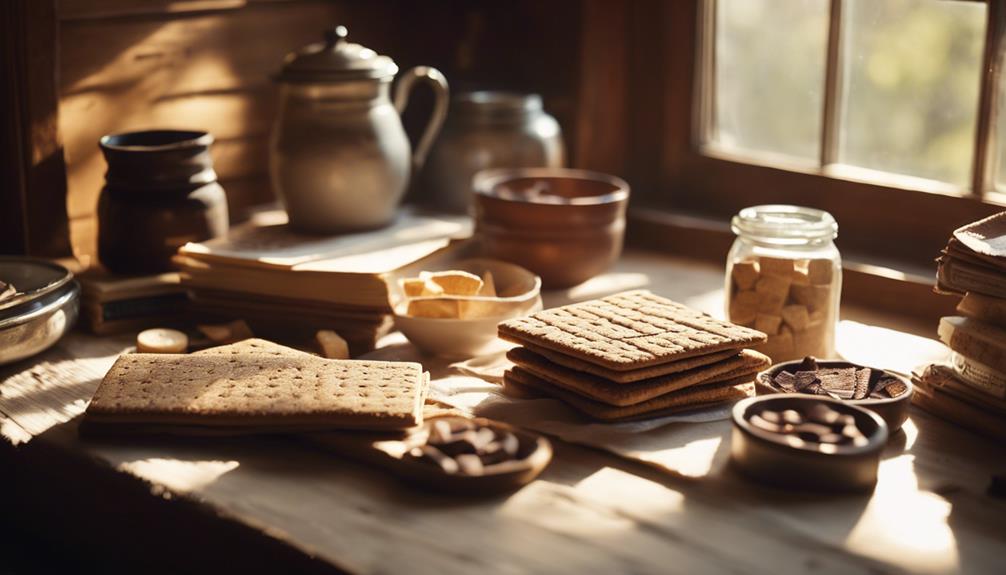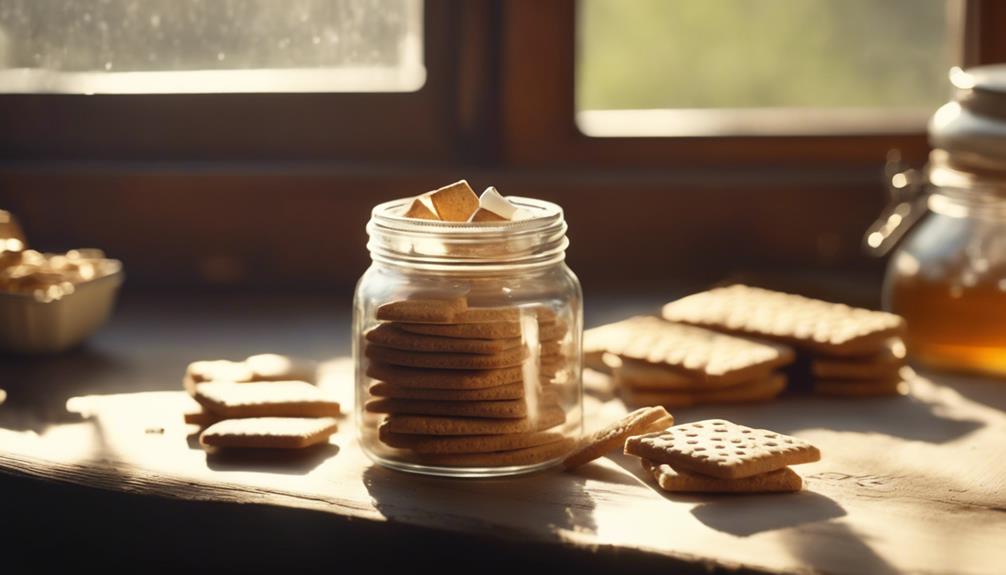Graham crackers have an unlikely origin story. They were invented in the 1820s by Rev. Sylvester Graham as a health food to suppress sexual urges. With a focus on whole grains and a bland diet, Graham aimed to promote healthier living and save souls. Over time, those diet restrictions morphed, and graham crackers became a staple in desserts, like s'mores and cheesecake crusts. Today, they're often sweetened and symbolize the balance between health and indulgence, embodying a cultural shift from their original purpose. Stick around, and you might uncover more surprising tales about these crunchy treats!
Key Takeaways
- Graham crackers were invented in 1829 by Rev. Sylvester Graham as a health food to suppress sexual urges and promote a bland diet.
- They were part of a larger health movement advocating for vegetarianism and the rejection of processed foods during the Industrial Revolution.
- Originally bland, graham crackers evolved into a sweet treat, becoming staples in desserts like s'mores and cheesecake crusts.
- Modern variations are often sweetened, reflecting a cultural shift from their original purpose to indulgence and pleasure in contemporary cuisine.
Invention and Purpose
Graham crackers were invented by Rev. Sylvester Graham in 1829 as a health food aimed at suppressing sexual urges, particularly masturbation. He believed that a bland diet could save souls from eternal damnation, and his creation became a cornerstone of this philosophy.
The crackers were part of a broader reformist movement that sought to combat indulgence and promote healthier living. By introducing these simple, unprocessed snacks, Graham hoped to encourage people to embrace a more disciplined lifestyle.
His vision extended beyond mere nutrition; it was about moral integrity and spiritual well-being. Despite their original purpose, graham crackers transformed over time, becoming a beloved treat rather than just a tool for restraint.
Dietary Philosophy
Rev. Sylvester Graham advocated for a strict vegetarian diet, aiming to eliminate alcohol, tobacco, and animal products for better health and spiritual clarity. He believed that a wholesome diet could lead to moral and physical improvement.
As you explore his philosophy, consider these key principles:
- Emphasis on whole grains and natural foods
- Rejection of factory-produced white bread, seen as unhealthy
- Spiritual benefits linked to clean eating
Graham's approach wasn't just about food; it was a lifestyle transformation.
Cultural Impact

The teachings of Sylvester Graham sparked a cult-like following that greatly shaped American dietary habits and cultural practices. His influence helped turn graham crackers into a staple in American diets, especially in desserts. You might recognize their impact in beloved treats like s'mores and cheesecake crusts. While Graham aimed for a bland, health-oriented snack, modern variations often include sweeteners, illustrating a shift in cultural perception. The table below highlights key aspects of this cultural transformation:
| Aspect | Description |
|---|---|
| Original Purpose | Suppress sexual urges, promote health |
| Popular Treats | S'mores, cheesecake crusts |
| Modern Adaptations | Sweetened versions of crackers |
| Cultural Symbol | Balance of health and indulgence |
Historical Context
Emerging during the peak of the Industrial Revolution, graham crackers reflect a society grappling with health and morality amidst rising processed foods.
As people became increasingly concerned about dietary choices, graham crackers served as both a response and a symbol of the early health food movement. You can see this historical context through:
- The rise of factory-produced foods prompting backlash from health advocates.
- Rev. Sylvester Graham's promotion of whole grains as a cure for societal ills.
- A burgeoning interest in vegetarianism and natural diets.
These elements highlight how graham crackers were more than just a snack; they embodied a pivotal moment in America's approach to food and wellness.
Modern Perception

While graham crackers once aimed for blandness, today's versions are often sweetened with honey and sugar, transforming them into a popular treat in various desserts.
You might enjoy them as a crunchy base for cheesecake or as a key ingredient in s'mores, reflecting a cultural shift from their original purpose.
This evolution highlights how perceptions of graham crackers have changed; they now symbolize indulgence rather than dietary restraint.
You're likely aware of their history, which adds depth to your appreciation of this snack.
Despite their sugary twist, graham crackers still resonate with health-conscious consumers, often marketed as a wholesome option.
This duality makes them a fascinating part of modern cuisine, bridging the gap between guilt and pleasure.
Frequently Asked Questions
Are There Gluten-Free Options for Graham Crackers Today?
Yes, you can find gluten-free graham cracker options today! Many brands offer alternatives made from almond flour, rice flour, or other gluten-free ingredients, allowing you to enjoy this treat without worrying about gluten intolerance.
How Are Graham Crackers Made Commercially?
Making graham crackers commercially is like crafting a delicious symphony. Manufacturers mix whole wheat flour, sweeteners, and leavening agents, roll the dough, cut it, then bake until golden, creating that irresistible crunch you love.
What Are the Nutritional Values of Graham Crackers?
Graham crackers typically contain around 130 calories, 2 grams of protein, 3 grams of fat, and 22 grams of carbohydrates per serving. They're often low in fiber and sugar, although variations may differ in nutritional content.
Can Graham Crackers Be Used in Savory Dishes?
Did you know that about 70% of Americans enjoy graham crackers? You can definitely use them in savory dishes! Try crushing them for a unique crust on chicken or mixing them into savory dips for added texture.
Where Can I Find Homemade Graham Cracker Recipes?
You can find homemade graham cracker recipes on food blogs, cooking websites, and social media platforms. Search for recipes that include whole wheat flour, honey, and butter for a delicious and healthier version.
Conclusion
You might be surprised to learn that the graham cracker's origins as a health reform tool didn't just promote bland diets but also sparked a culinary revolution.
What started as a means to curb indulgence has transformed into a beloved snack, often associated with guilty pleasures like s'mores and cheesecake.
This unexpected twist in their history reveals a fascinating truth: sometimes, the path to indulgence is paved with good intentions, and it's okay to savor life's sweet moments.









